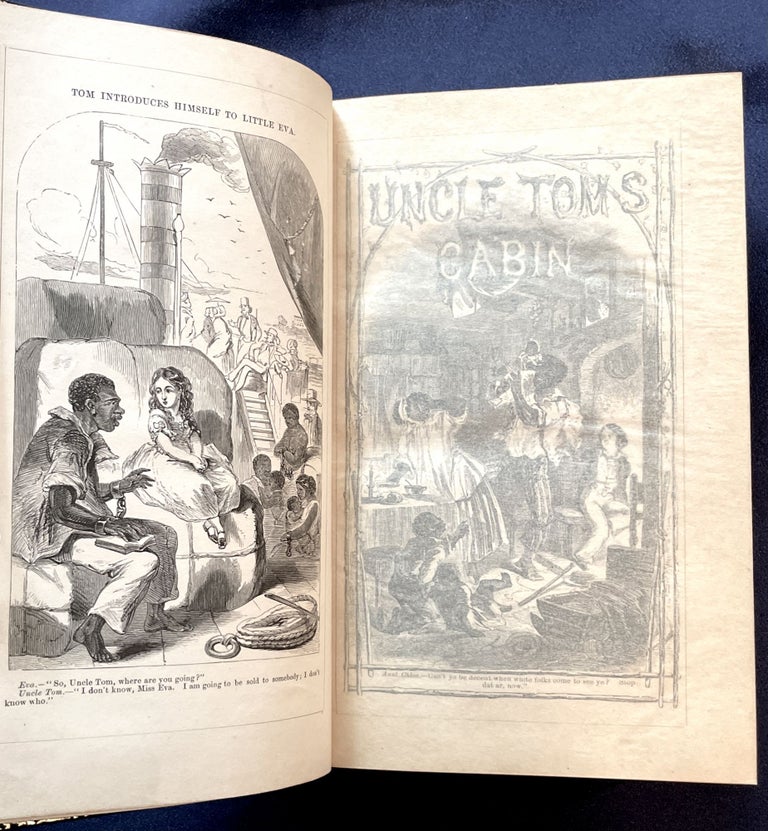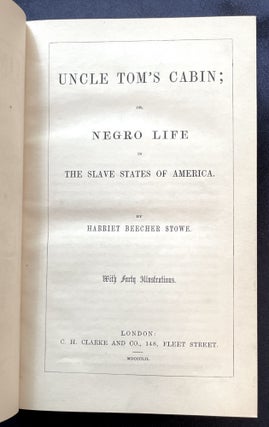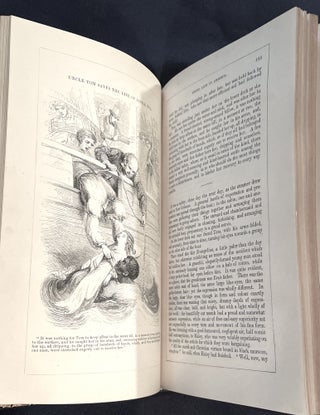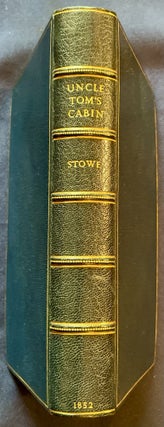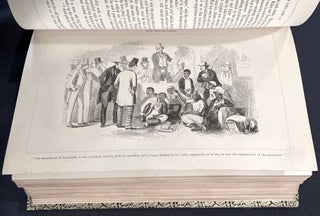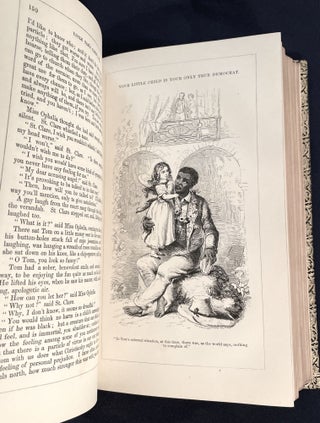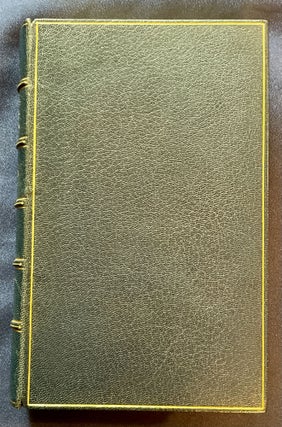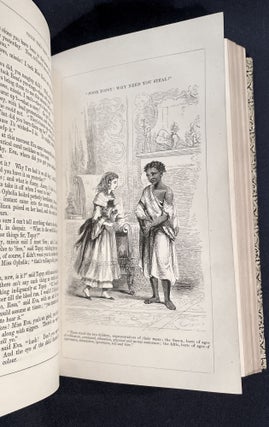UNCLE TOM'S CABIN; Or Negro Life in the Slave States of America / By Harriet Beecher Stowe / with Forty Engravings
London: C. H. Clarke and Co., 1852. Newly Illustrated Third English Edition from 1852, year of the First American and British Editions. Full Morocco leather. 8vo, full black morocco with gold title on spine, five hubs, a single gilt ruled border & gilt inner dentelles; engraved frontispiece (displaced from p.124) and engraved title page [perhaps after Cruikshank] with sundry tissue guards, plus 40 mostly original steel-cut illustrations [likely from various contemporary sources or original], marbled endpapers, a.e.g., xii, 355 pages. Very Fine / None. Item #7201
Uncle Tom's Cabin was the best-selling novel and the second best-selling book of the 19th century, following the Bible. Harriet Beecher Stowe's (1811-1896) melodramatic historical novel of 1852 informed and inflamed the abolitionist cause in the 1850s.
Uncle Tom's Cabin was initially serialized; then published in book form by John P Jewett and Company, Boston, on March 20, 1852, with engraved cover and six illustrations by Hammatt Billings (1818-1874), an architect-and- draughtsman with profound Abolitionist sympathies and involvement.
The novel sold 3,000 copies on its first day and some 5,000 copies in four days. During its first year, it sold more than 300,000 copies in the United States and "more than two million in the rest of the world" (The Annotated Uncle Tom's Cabin [UTC], 2007, p.xliii). At least 14 other editions were printed by various publishers in 1852; four more in 1853.
Clarke and Co. is identified as the earliest English Edition by BAL (19518, col. 2). According to Sabin, it was printed from "the tenth American edition" (p.47). The plates were shipped from America to France in April, where it was soon picked up by Vizzetelly for Clarke and Co. (Sabin, p.48).
Clarke's edition was published in April-May of 1852, but only had 300 pages, so our expanded illustrated edition is derivative but slightly later. Sabin places our edition immediately after the "Third [British] Edition" (p.47). The Preface to our edition confirms that it isn't the first edition for "thousands of copies are already quietly at work" [viz., sapping the foundations of slavery] (p.v).
The demand being enormous, publishers' had a powerful need to enhance and differentiate their successive editions. Thus, Clarke and Co. followed this "Forty Engravings" Illustrated Third Edition in late 1852 with another edition that year with a "New Preface" by Harriet Beecher Stowe; then with a mass market 12mo having 190 pages but "With Fifty Splendid Illustrations" (Sabin, op. cit.).
In late October, 1852, a John Cassell London edition with 27 illustrations on wood by George Cruikshank (who had been influenced by Billings' images) was issued in 13 weekly numbers (cp. Sabin, p.47). Cruikshank's illustrated edition is sometimes mistakenly identified as the "First English Edition."
London publisher Thomas Allman also printed an illustrated 1852 edition in November (not seen). (For an excellent overview of UTC' illustrations see: http://utc.iath.virginia.edu/interpret/exhibits/morgan/morgan.html.)
The "forty" excellent illustrations in our edition have not--most regretably--been credited to any artist or engraver. The illustrated title page, for instance, is not that created by talented Hammatt Billings for the Boston first edition (1852). Indeed, the Clarke' engraved title page seems derivative from George Cruikshank, or perhaps by one of Cruikshank's emulators.
Billings also created 117 illustrations for the John P. Jewett & Co. "Splendid Edition" that appeared very late in 1852, but these images also are not repeated in our copy. ("Splendid Edition" images by Billings may be accessed via http://utc.iath.virginia.edu/uncletom/illustra/53illf.html.)
The title page of our edition reworks images originated by George Cruikshank, which appear to have been further reworked by other engravers such as "Jackson" [not further identified] in the plate "Uncle Tom at Home" (and perhaps W. Measom's work in The Uncle Tom's Cabin Almanack, or, Abolitionist Memento, 1853 [see pp.30 & xxxiii in The Annotated Uncle Tom's Cabin, 2007]).
The Cruikshank-Measom linkage may also be suggested by our volume's image (p.54) of a slave mother who holds her child in one hand and a knife in the other as she tries to fend off a sailor or leap into a watery grave (compare the wood engraving on p.75 in The Annotated UTC). Our engravings tend to enlarge and make more dynamic parallel examples.
Likewise, there are thematic parallels between Cruickshank's image "Persecuted Virtue" in which a black slave with whip in hand is shown beside a slave woman stripped to her waist, a painful semi-nude image repeated in the more dynamic plate of our volume on page 94.
Likewise, when Uncle Tom saves Eva from drowning, the Cruikshank woodcut and that by "Thomas W. Strong after Cruikshank" somewhat resembles ours (Annotated UTC, pp.157 & 158, and our plate p.124). Underlying both, though, is probably Billings' famous kneeling slave supplicating Christ that appeared on many designs.
Further comparison with the seven first American edition engravings by Billings indicates that one, at least, "the Auction Sale" has been recycled onto our page 101. It depicts the public sale of the slave Aunt Hagar and her fourteen-year old son (Cp. page 127, The Annotated UTC).
Most of Bilings' many illustrations for UTC have not been recycled in this edition; nor have many of Cruikshank's very popular engravings. Preliminary inspection suggests that most of the illustrations in this Third Edition, Illustrated are original, though they often retain derivative echoes of Uncle Tom's features, like those of Topsy and Little Eva, and other characteristics.
Images of Topsy and Eva (e.g., our p.209) also bear a resemblance to lithographs by Louisa Corbaux published in 1852, so perhaps Clarke & Co. raided several published sources for its illustrations.
We also note that the plate indentified by the "List of Illustrations" as intended for page 124, which shows the discourse between Uncle Tom and Little Eva on the steamer, has been relocated--by the publisher or binder--as a frontispiece opposite the illustrated title page. (This image seems to have been reversed by Thomas W. Strong in an undated lithograph reproduced on p.155 of The Annotated UTC.)
Superbly bound in very fine black Morocco by a Riviere-type bindery, this is a very well illustrated 1852 edition of the monumentally influential anti-slavery classic novel (BAL 19343, p.73). The leather is of exceptional quality and condition. The pages are remarkably clean, bright, and tight in the fine Riviere-style binding. The frontispiece, title page, and illustrations are crisp, sharp, and generally very clean. Very light uniform age-toning. There are a few very faint traces of foxing. No marks by previous owners!
Price: $495.00

